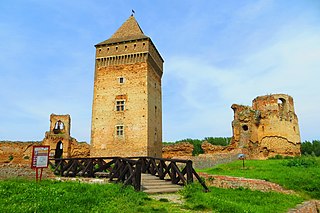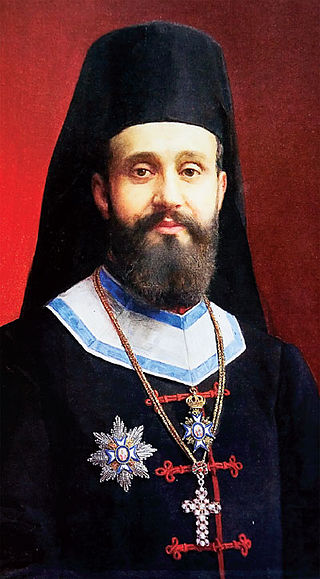
Sremski Karlovci is a town and municipality located in the South Bačka District of the autonomous province of Vojvodina, Serbia. It is situated on the banks of the Danube, 8 kilometres from Novi Sad. According to the 2011 census results, it has a population of 8,750 inhabitants. The town has traditionally been known as the seat of the Serbian Orthodox Church in the Habsburg Monarchy. It was the political and cultural capital of Serbian Vojvodina after the May Assembly and during the Revolution in 1848.

The South Bačka District is one of seven administrative districts of the autonomous province of Vojvodina, Serbia. Geographically it lies in the southern part of Bačka and northern part of Syrmia. According to the 2022 census results, it has a population of 607,178 inhabitants. The administrative center of the district is the city of Novi Sad, which is also the capital and the largest city of the Autonomous Province of Vojvodina.

Josif Rajačić, also known as Josif Rajačić-Brinski, was a metropolitan of Sremski Karlovci, Serbian Patriarch, administrator of Vojvodina, and baron.

Stevan Šupljikac, known simply as Vojvoda Šupljikac was a Serbian voivode and the first voivode of the Serbian Vojvodina.

The Serbian Vojvodina was a short-lived self-proclaimed Serb autonomous province within the Austrian Empire during the Revolutions of 1848, which existed until 1849 when it was transformed into the new (official) Austrian province named Voivodeship of Serbia and Banat of Temeschwar.

The Serbs of Vojvodina are the largest ethnic group in this northern province of Serbia. For centuries, Vojvodina was ruled by several European powers, but Vojvodina Serbs never assimilated into cultures of those countries. Thus, they have consistently been a recognized indigenous ethnic minority with its own culture, language and religion. According to the 2022 census, there were 1,190,785 Serbs in Vojvodina or 68.43% of the population of the province.

The Eparchy of Srem is an eparchy (diocese) of the Serbian Orthodox Church in the Syrmia (Srem) region, Serbia. Most of the eparchy is in the autonomous province of Vojvodina, and it also includes a small south-eastern part of Syrmia within the city limits of Belgrade, as well as some West Syrmian parishes in the border region of Croatia. The seat of the eparchy is at Sremski Karlovci. Since 1986, the diocesan bishop is Vasilije Vadić.

The Metropolitanate of Karlovci was a metropolitanate of the Eastern Orthodox Church that existed in the Habsburg monarchy between 1708 and 1848. Between 1708 and 1713, it was known as the Metropolitanate of Krušedol, and between 1713 and 1848, as the Metropolitanate of Karlovci. In 1848, it was elevated to the Patriarchate of Karlovci, which existed until 1920, when it was merged with the Metropolitanate of Belgrade and other Eastern Orthodox jurisdictions in the newly established Kingdom of Serbs, Croats and Slovenes to form the Serbian Orthodox Church.

The Patriarchate of Karlovci or Serbian Patriarchate of Sremski Karlovci, was a patriarchate of the Eastern Orthodox Church that existed between 1848 and 1920. It was formed when the Metropolitanate of Karlovci was elevated to the rank of patriarchate. The Patriarchate of Karlovci nominally existed until 1920, when along with several other Eastern Orthodox jurisdictions in the defunct Austro-Hungarian Empire, as well as the Metropolitanate of Cetinje, it was merged with the Metropolitanate of Belgrade to form the united Serbian Orthodox Church. The seat of the Patriarchate was in Karlovci.

Stevan Petrović, KCMT, known as Stevan Knićanin was a Serbian voivode (commander) of the Serbian volunteer squads in Serbian Vojvodina during the 1848 revolution.

May Assembly was the national assembly of the Serbs in Austrian Empire, held on 1 and 3 May 1848 in Sremski Karlovci, during which the Serbs proclaimed autonomous Serbian Vojvodina. This action was later recognized by the supreme Austrian authority in Vienna. The May Assembly was part of the European Revolutions of 1848.
The International Novi Sad Literature Festival is a literary festival held annually in the city of Novi Sad, Serbia. It was founded by the Association of Writers of Vojvodina in 2006. It is held еvery year in August and September.

The Patriarchate Court is a listed historical building which was the seat of the Patriarchate of Karlovci between 1848 and 1920, in Sremski Karlovci, Serbia.

Nikanor Grujić was the Serbian Orthodox bishop of Pakrac, the locum tenens Serbian Patriarch, the Austro–Hungarian emperor's Privy Councilor, knight of the Grand Cross of the Franz Joseph order, member of Houses of Magnates at Hungarian and Croatian–Slavonian parliaments, member of Serbian Learned Society, writer, poet, orator and translator.

The Serb uprising of 1848–49, also known as the Serb revolution of 1848–49 and Serb People's Movement of 1848–49, took place in what is today Vojvodina, Serbia, and was part of the Revolutions of 1848 in the Austrian Empire. During the Hungarian Revolution, Hungarians achieved significant military successes, but were defeated after Russian intervention. Serbs led fierce battles against the Hungarians for autonomy or merge with the help of volunteers from the Principality of Serbia. The outcome of the uprising was the establishment of Serbian Vojvodina, a special autonomous region under the Austrian crown. However, the Voivodeship failed certain expectations that Serbian patriots had expressed at the May Assembly (1848). Serbs did not constitute an absolute majority of the population, while the administration was largely in the hands of German officials and officers. The Voivodeship was abolished in 1860, however, some rights were kept by the Serb community. The Serbian Patriarchate was renewed, while the uprising had increased national awareness of the Serb people north of the Sava and Danube in the struggle for freedom.
Serbian Patriarchate may refer to:

Lukijan Bogdanović was the last Orthodox Patriarch of the Patriarchate of Karlovci and Metropolitanate of Karlovci. He was assassinated and decapitated while walking alone along a river bank in Bad Gastein. He was a prominent benefactor and member of Privrednik.
Vladimir Nikolić, was a Serbian architect notable for his projects built in Vojvodina province. He mostly worked in Neo-renaissance, Neo-romanticic and Serbo-Byzantine Revival styles.
Milenko Filipović is a politician in Serbia. He was the mayor of Sremski Karlovci from 2004 to 2016 and was also a member of the Assembly of Vojvodina from 2008 to 2011. At different times in his career, Filipović was a member of G17 Plus and the Democratic Party.
The Serbian People's Church Council of Karlovac Metropolitanate represented the most important institutions of Serbs in the Habsburg monarchy.















